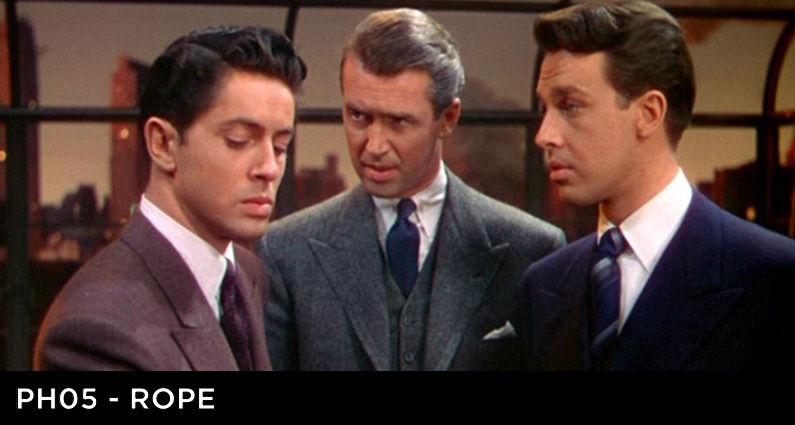Podcast: Play in new window | Download (Duration: 57:20 — 33.1MB) | Embed
Gooooood evening. In this months episode of Presenting Hitchcock, Cory and Aaron mark themselves amongst the superior few as they discuss “Rope”.
Trailer:
The Picture:
Picture Title: Rope
Written by: (Play) Patrick Hamilton, (Adaptation) Hume Cronyn, (Screenplay) Arthur Laurents
Starring: John Dall, Farley Granger, Edith Evanson, Douglas Dick, Joan Chandler, Sir Cedric Hardwicke, Constance Collier, James Stewart, Dick Hogan
Directed by: Alfred Hitchcock
Year Released: 1948
Our Favourite Trivia:
DIRECTOR CAMEO: appears, though barely if at all recognizable, walking down the street during the opening credits. His profile also appears on a neon sign visible through the apartment window approximately fifty-five minutes into the movie. The neon sign advertises “Reduco”, the same fictional weight-loss product that Hitchcock advertised in his famous newspaper ad cameo in Lifeboat (1944).
Sir Alfred Hitchcock’s first color movie.
This movie was unavailable for three decades because its rights (together with four other movies of the same period) were bought back by Sir Alfred Hitchcock and left as part of his legacy to his daughter Patricia Hitchcock. They’ve been known for a long time as the infamous “five lost Hitchcocks” amongst movie buffs, and were re-released in theaters around 1984 after a thirty-year absence. The others are Rear Window (1954), The Man Who Knew Too Much (1956), The Trouble with Harry (1955), and Vertigo (1958).
In the documentary Rope Unleashed, we learn that Hume Cronyn was a writer on the film, and also Arthur Laurents who crafted the final screenplay elaborates that the central relationship of Brandon and Phillip were obviously homosexuals, yet you could not say this nor directly allude to it, and IT was the constant reference and the line My dear Boy was marked by studio executives as needing to be excised because it screamed of homosexuality. The teacher, was supposed to also be homosexual and wanted Cary Grant but turned it down because he didn’t want to be identified with IT, and the teacher backstory was supposed to have influenced these boys with Nietzsche’s philosophy with the Superman, and also had an affair with one of them. But Jimmy Stewart never had an affair with anyone, and didn’t have the sexual center originally intended, and instead essentially became a mere detective. He also says, the murder was never meant to be shown at the beginning. You were supposed to wonder the entire time if there was a body in that chest.
This story was very loosely based on the real-life murder committed by University of Chicago students Nathan Leopold and Richard Loeb, which was also the (fictionalized) subject of Compulsion (1959) and Swoon (1992).
The theatrical trailer features footage shot specifically for the advertisement that takes place before the beginning of the movie. David (the victim) sits on a park bench and speaks with Janet before leaving to meet Brandon and Phillip. James Stewart narrates the sequence, noting that’s the last time Janet and the audience would see him alive.
This movie was shot in ten takes, ranging from four and a half minutes to just over ten minutes (the maximum amount of film that a camera magazine or projector reel could hold). At the end of the takes, the movie alternates between having the camera zoom into a dark object, totally blacking out the lens/screen, and making a conventional cut. However, the second edit, ostensibly one of the conventional ones, was clearly staged and shot to block the camera, but the all-black frames were left out of the final print. Most of the props, and even some of the apartment set’s walls, were on casters, and the crew had to wheel them out of the way and back into position as the camera moved around the set.
Sir Alfred Hitchcock only managed to shoot roughly one segment per day. The last four or five segments had to be completely re-shot, because Hitchcock wasn’t happy with the color of the sunset.
Although this movie lasts one hour and twenty minutes, and is supposed to be in “real time”, the time frame it covers is actually longer, a little more than one hour and forty minutes. This is accomplished by speeding up the action: the formal dinner lasts only twenty minutes, the sun sets too quickly, and so on. The September 2002 issue of “Scientific American” contains a complete analysis of this technique (and the effect it has on the viewers, who actually feel as if they watched a one hour and forty minute movie).
The Random Draw for Next Picture:
Next up, we’ll be discussing “Number Seventeen.”
Add It To Your Library:
Do you want to buy this movie (from Amazon or iTunes)? Do you want to help support Presenting Hitchcock and the other Golden Spiral Media podcasts? You can do that by clicking this link: https://www.goldenspiralmedia.com/support. We would greatly appreciate it!
Feedback:
Send in your feedback by calling 304-837-2278 or by visiting www.goldenspiralmedia.com/feedback
Follow the show on Facebook or Twitter @HitchcockGSM
[sc:ph]
